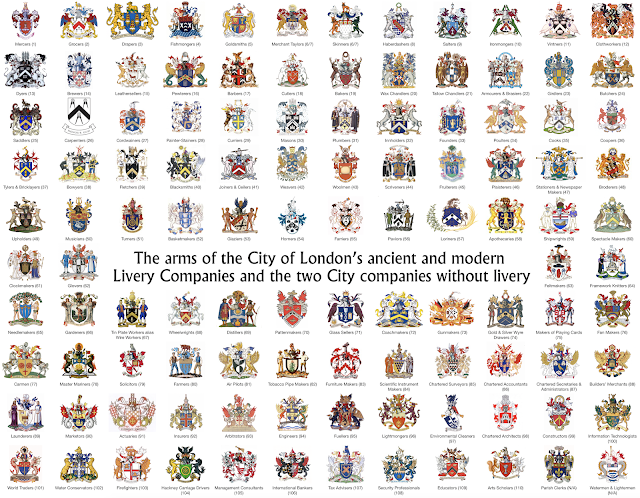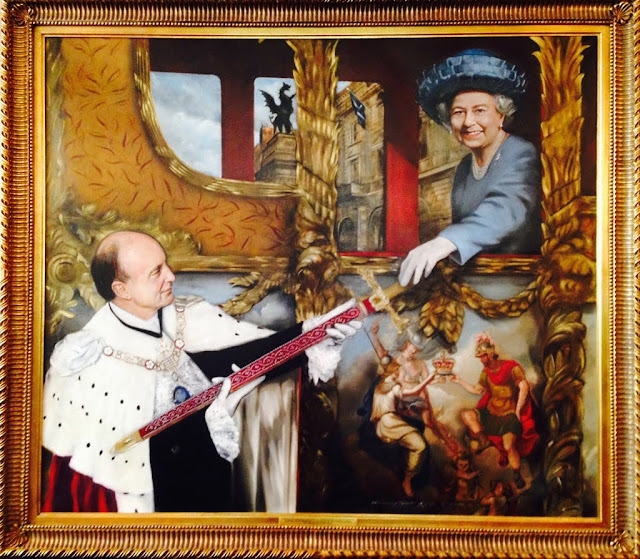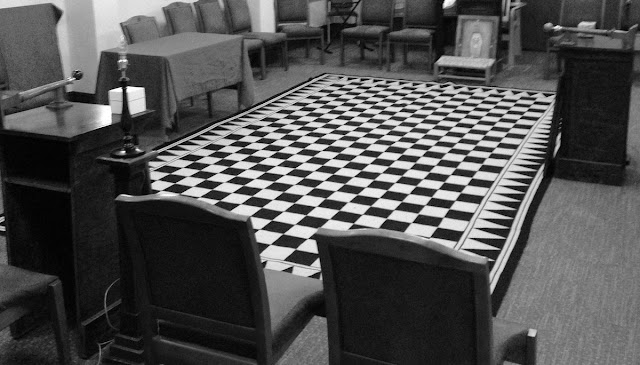What exactly is a Livery Company?
The tragic terrorist attack of Friday 29th November 2019 that took place within and outside Fishmongers’ Hall at the northern end of London Bridge threw a spotlight on that building and the organisation that owns it, but also more widely on these curious City of London institutions called Livery Companies.
The events that took place in the hall and then spilled out onto the pavement caused a peak in interest on social media about the Fishmongers’ Hall, not least because of the heroism of the staff as reported by the Company's Clerk (Commodore Toby Williamson) on the BBC News. Social Media was alive with questions about whether the Fishmongers' Hall was a pub, a fishmonger's shop, perhaps even a fish and chip shop... it is none of those things.
This blog seeks to explain what a Livery Company is (in the UK) for those who may wish to learn more. Reduced the simplest description a Livery Company is an occupational guild formed by Royal Charter, but that hardly helps explain what they are, so read on...
The events that took place in the hall and then spilled out onto the pavement caused a peak in interest on social media about the Fishmongers’ Hall, not least because of the heroism of the staff as reported by the Company's Clerk (Commodore Toby Williamson) on the BBC News. Social Media was alive with questions about whether the Fishmongers' Hall was a pub, a fishmonger's shop, perhaps even a fish and chip shop... it is none of those things.
This blog seeks to explain what a Livery Company is (in the UK) for those who may wish to learn more. Reduced the simplest description a Livery Company is an occupational guild formed by Royal Charter, but that hardly helps explain what they are, so read on...
 |
| Coats of Arms of the City of London's 110 Livery Companies, and two Companies without Livery |
A thing without comparison
The first challenge one faces when explaining a Livery Company is that of its unique nature. No two Livery Companies are identical and none of them are directly comparable with others social, political or cultural constructs – yet they exhibit aspects of all three of these facets of society.
The entirely understandable desire to compare the Livery Companies with some other institution that is more readily understood results in all sorts claims that bare no relationship to the reality of the Livery Companies. More on that further on...
The first challenge one faces when explaining a Livery Company is that of its unique nature. No two Livery Companies are identical and none of them are directly comparable with others social, political or cultural constructs – yet they exhibit aspects of all three of these facets of society.
The entirely understandable desire to compare the Livery Companies with some other institution that is more readily understood results in all sorts claims that bare no relationship to the reality of the Livery Companies. More on that further on...
There’s no Livery without history
While the City’s 110 Livery Companies remain relevant in the 21st century, it’s impossible to place them in the present without a brief look to their past. Nobody would invent a Livery Company from scratch today, and their evolution over centuries has endowed them with a variety of roles.
The earliest Livery Companies probably started as religious guilds with an occupationally aligned membership. Early medieval London had over 140 churches, several monastic intuitions and the cathedral of St Paul. Since the various trades and crafts tended to gather in particular areas of the City, the merchants and craftsmen lived close by and probably prayed together.
It’s not a great leap from there to understand why they might have gathered together to feast and drink, to share the knowledge of their occupations, to raise sons as apprentices, and to provide for widows and orphans.So the guilds took on an increasingly occupational focus. They established rules of governance, elected officers, members paid a subscription, and the wealthier guilds began to build halls in which business was transacted, religious feasts were observed and members met to agree ordinances for the regulation of their occupation.
It was from these roots that the Livery Companies flourished.In the interests of brevity we now need to skip almost 1,000 years of development, since some of the earliest Livery Companies began as Guilds prior to the Norman Conquest. This article doesn’t have space for even a concise history of the Guilds and their evolution to become Livery Companies, moreover than story has been immensely well researched and documented by historians going back as far as the Tudor era.
Broadly the Livery Companies are grouped into the ancient companies (Butchers, Bakers, Candlestick Makers and so on) and the modern companies (Architects, Engineers, Surveyors, Educators, etc).
There are 110 Livery Companies in total, and five more in the making. Broad generalisations about the Livery Companies soon fall into the trap of stereotyping and phrases such as ‘Gentlemen’s Club’, ‘Masonic Body’ or ‘Early Trade Union’ are a sure sign of ignorance of what a Livery Company actually is.
These lazy comparisons are not helpful, but they are understandable for the reasons given above.
Let’s deal with these comparisons before we go further by clearly stating that Livery Companies are not now and were never clubs for gentlemen (they admit women), secret societies, offshoots of Freemasonry or anything like an early mass labour movement body working to improve the conditions of rank and file workers.
Some Livery terminology
The word 'Livery' simply refers to the uniform worn by the officers of the Company. Each Livery Company has its own colours and its own coat of arms much as universities have different academic dress.
The senior elected officer of a Livery Company goes by the title of Master, Prime Warden or Upper Bailiff. He or she is elected to chair the Company's Court (board of governors).
The senior employee of a Livery Company is titled the Clerk - an appointment sometimes described as CEO outside the Livery to make it easier to understand.
That said, direct comparisons with the structure of a modern company are not particularly useful as a Livery Company has no shareholders, produces no products, offers no services, does not trade, and as a Royal Charter Corporation it is not required to submit accounts to Companies House.
The Livery Companies today, their role and relevance
A very quick summary of the work of the City of London’s 110 Livery Companies in the 21st century identifies four major areas of activity:
1) Charity. The principal activity of the Livery Companies today is that of charitable work, whether by making financial donations to good causes, by providing pro bono time and talent of the membership, by bringing worthy causes together with businesses at networking events, hosting fund raising events, or by enabling other charities to use their premises.
2) Trade. Some of the Livery Companies are also involved in the regulation of their occupation, a particularly good example is the Gunmakers’ Company which still tests all smallbore firearms in the UK. Another is the Farriers’ Company which operates a register of qualified farriers subject to the Farrier Registration Act (1974). The Goldsmiths’ Company run the Assay Office in London and it is from their marking of gold, silver, platinum and palladium that we get the term ‘hall mark’.
3) Education. Some of the Livery Companies are engaged in running Apprenticeship schemes such as that operated by the Shipwrights’ Company. Several of the Companies are also involved in the governance of schools; Gresham’s, Oundle, Haberdashers’ Aske’s, St Paul’s and more recently Hammersmith Academy are but a few among many founded, funded and governed by the Livery Companies.
4) Fellowship. Every Livery Company is a membership organisation, its strength comes from the commitment the Freemen (junior members) and Liverymen (senior members) make to the life of the Company, to charitable work, to school governorships, to upholding standards in trade and other aspects of the Company’s life.
The Livery Companies bring their membership together in a wide array of sporting and social activities including some spectacular banquets, but this is just the cherry on the cake… it is by no means the whole story. In additional to the four cardinal points, the Livery is also active in six other areas:
1) Support to the Lord Mayor and the City of London Corporation. The Liverymen (senior members) of the Livery Companies elect the City’s two Sheriffs and the approve the candidates for election to the office of Lord Mayor. The Sheriffs and the Lord Mayor serve a single term of 12 months (unpaid) and every candidate will be a member of one of more Livery Companies. It is the City’s Livery Committee (a body that brings together the Livery Companies and the City of London Corporation) that manages the annual election process. The Livery Companies also participate in the Lord Mayor’s Show and support the annual Lord Mayor’s Appeal.
2) Support to HM Armed Forces. Every Livery Company will have at least one and typically multiple military affiliations with Royal Naval ships, shore stations, Regiments and Corps of the British Army, and Squadrons of the Royal Air Force. Each Livery Company finds its own way to bringing its relationship with the military to life, some are engaged in career development for officers and enlisted ranks, others are involved in awards and prize giving, others participate in joint charitable activities.
3) Support to Uniformed Youth Groups. Most Livery Companies are affiliated with one or more Cadet Forces units, some are affiliated with St John Ambulance Cadets and the Worshipful Company of Fire Fighters is affiliated with a group of Fire Brigade Cadets in London. As with the military affiliations the nature of the partnership with uniformed youth groups will vary from one to the next, but most invite the cadets to form a guard of honour at formal banquets.
4) Support to the Church. Several of the Livery Companies have the Benefice (right to appoint the Priest) at numerous parish churches around England. Sometimes this Benefice is shared with another organisation such as an ancient university. Every Livery Company maintains links with a church in the City of London and usually conducts (at the very least) an annual service on day of installing its Master for the year ensuing and a carol service in the run up to Christmas. Most Companies will also appoint an Honorary Chaplain, and the membership of the Company are considered part of the church’s parish.
5) Patronage of the Arts. The Livery Companies have a long history of commissioning portraits, gold and silverware, songs and anthems, and performances of all sorts. Several of the Companies award prizes at the Guildhall School of Music and Drama, others, such as the Worshipful Company of Musicians, support talented musicians in their early careers.
6) Preservation of Culture and Heritage. Several of the Livery Companies own a hall in the City of London, some of these halls are of ancient origin, others are post World War Two rebuilds on the same site as an earlier hall. The halls contain a bewildering array of treasures from ancient manuscripts to modern art pieces, and yes - even the occasional narwhal tusk. The Livery Companies are both owners and custodians of these treasures, and they also maintain many customs and traditions that form part of the cultural history of England. One tradition that all Livery Companies observe is that of the Loving Cup which is shared during formal banquets.
Taken together these aspects of the life of a Livery Company provide a bewilderingly diverse array of activities, affiliations and associations that are not found in any other sort of organisation. Even among the Livery Companies there are enormous differences in the way these aspects are conducted.
The Fishmongers’ Company still inspects the quality of fish at Billingsgate Market, while the Pattenmakers’ Company has reinvented itself to ally with the development of prosthetic limbs. The Air Pilots’ Company has a flourishing profession and acts as the professional body for aviation (civil and military), whereas the Horners’ Company has found new relevance in the plastics industry. The Farmers’ Company is increasingly active in the field of technology in farming, the Goldsmiths have funded a new gallery in the Museum of London. No two Livery Companies are the same, but they all remain relevant in the 21st century.
Want to learn more about the Livery Companies and the City of London?
The City of London Freeman's Guide is the definitive concise guide to the City of London and its ancient and modern Livery Companies, their customs, traditions, officers, events and landmarks. Available in full colour hardback and eBook formats and now in its fifth or Platinum Jubilee edition. The guide is available online from Apple (as an eBook), Amazon (in hardback or eBook) Payhip (in ePub format) or Etsy (in hardback or hardback with the author's seal attached). Also available from all major City of London tourist outlets and bookstores. Bulk purchase enquiries are welcome from Livery Companies, Guilds, Ward Clubs and other City institutions and businesses.
The City of London Freeman's Guide is the definitive concise guide to the City of London and its ancient and modern Livery Companies, their customs, traditions, officers, events and landmarks. Available in full colour hardback and eBook formats and now in its fifth or Platinum Jubilee edition. The guide is available online from Apple (as an eBook), Amazon (in hardback or eBook) Payhip (in ePub format) or Etsy (in hardback or hardback with the author's seal attached). Also available from all major City of London tourist outlets and bookstores. Bulk purchase enquiries are welcome from Livery Companies, Guilds, Ward Clubs and other City institutions and businesses.
 |
| The City of London Freeman's Guide, 6th or Sovereign's edition |
I welcome polite feedback and constructive comment on all my blog articles. If you spot and error or omission, please do let me know (please illustrate with verifiable facts linked to an authoritative source where appropriate).
I ask that all persons who wish to comment take the time to register as I receive copious spam and postings from crackpot conspiracy nuts which would otherwise overwhelm my blog with rubbish and nonsense.
I ask that all persons who wish to comment take the time to register as I receive copious spam and postings from crackpot conspiracy nuts which would otherwise overwhelm my blog with rubbish and nonsense.



Comments
Post a Comment